
 |
On Friday’s Democracy Now, Amy Goodman rounded out the broadcast by retrieving a gem from the Pacifica Radio archives:
In May of 1962, the legendary folksinger Bob Dylan came by the WBAI studios in New York to perform his rarely heard tribute to Emmett Till. This is one of the earliest known live recordings of Bob Dylan.
It was recorded within days of his 21st birthday. "The Ballad of Emmett Till" never appeared on an official Bob Dylan record and was only released on a compilation put out by Broadside Records (on which Dylan recorded under the pseudonym Blind Boy Grunt).
You can hear it here.
This is but a foretaste of the Dylan rarities soon heading our way. On September 26 and 27, PBS will broadcast the Martin Scorsese directed Dylan biography “No Direction Home,” focusing on the singer-songwriter’s life and music from 1961-1966.
This will be preceded by the release of the soundtrack this Tuesday. Volume 7 of the Bootleg Series, the new two-CD set features - among many other previously unreleased tracks - what is believed to be Dylan’s earliest recorded original song: "When I Got Troubles” from 1959.
Given the gathering storm of our present moment in history, it seems a ripe time to revisit the emergence of the force that is Bob Dylan. As always, The Bard’s timing remains uncanny.
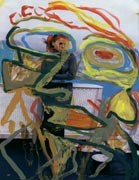 |
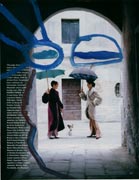 |
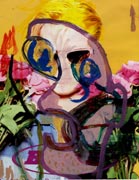 |
The golf club is analogous to the paint brush. Despite an afternoon’s circuitous trek through compelling pastoral vistas punctuated by dramatic physical exertion, it doesn’t take long to realize that, fundamentally, golf is a mental discipline. Last week, for the first time, I tried my hand at a round of golf and, in this one regard, the terrain was familiar.
For years, Chuck Close has used golf as a metaphor to offer entrance into his particular painting process. In searching the web, I found a fascinating and extensive 1987 interview with the artist wherein he explains:
Golf is kind of interesting. It's a stupid sport, but I like it because it's the only sport that I can think of in which you move from general to specific. When you're standing at the tee, you often can't even see the green or the hole where you're going to ultimately end up. So the first stroke is just out there somewhere, and the second stroke attempts to correct and refine the direction. On a par four course, by the third stroke, you should be on the green. You're now getting very close to what you want, and then you hopefully can putt out on the fourth stroke. Now you're someplace very specific --this very small circle. I like the idea of having a certain number of steps to take to move from general to specific, and I like the idea of building a painting rather than painting it. So I conceived of each one of the squares in the original oil paintings as a kind of par four course. But just to make things more interesting, I would tee off in the opposite direction.
•••
(Y)ou always have the possibility of coming in a stroke early with a birdie. Clearly, I'm not going to stop until it's right. I'll put on as many strokes as necessary, just as in playing golf you've got to keep making strokes until you find the green. So, you could get a bogey or a double bogey or you can have the aesthetic equivalent of being mired down in the sand trap, where you keep making stroke after stroke after stroke and not getting anywhere.
With the three new paintings posted above, I was definitely going for the green, aiming to bring the works to resolution in an economical, direct manner. As to whether they hit the mark or warrant the charity of a mulligan, I’ll let you be the official scorer.
In the end, for my maiden round of golf, I shot a 56 over nine holes. Gotta work on my putting.
Since the art of making it becomes a huge aspect of the making of art, TINSQUO has created an ongoing feature called What It Takes or W.I.T., for short. These interviews explore the application of Will from myriad angles pertaining to artistic life and success in New York City.
FINALLY, FUNDING!
On the occasion of her Thriftshop Theater Workshop’s first show funded by an outside source, we meet the company’s cofounder, Gina DeMayo.
Three years and five shows into life beyond college, things are going full steam for the actor turned producer. With an August double bill of “Twelfth Night” and “Hamlet,” quickly followed by Sam Shepard’s “A Lie Of The Mind” in October, the company formed by two women fed up with auditioning 578th for unpaid children’s theater in Jersey are on a non-stop drive towards Destiny.
On an Avenue A rooftop in Manhattan’s East Village, Gina gives us her angle on what it takes to build a theater company in New York.
So, how did it come about that your upcoming DUMBO Shakespeare production is receiving this magical funding?
Someone from the Brooklyn Bridge Park Conservancy came to see our last run of “Twelfth Night” through a contact of our director, Nina Pinchin, and we were promptly invited to add some live theater to their calendar. Just like that. They have a fairly new arts program out under the Brooklyn Bridge.
This is also Thriftshop Theatre Workshop’s first outdoor event. What has planning for that been like?
Well, we go out there to investigate a couple of weeks ago [around July 6th] and I’m expecting a tent, ya know? Maybe a couple of chairs. I’m thinking, ‘Well, if it rains, not everybody will come...I can live with that.’
BUT when we arrived at the park, which is right in between the Brooklyn and Manhattan Bridges on the East River, we found a gorgeous space called the Old Tobacco Warehouse. It’s brick, all brick, a shell about 120 ft. in length and 60 ft. in depth and FILLED with this white, glorious tent which rents for $7K per night if you’re having a private function!
So, the park is supplying everything that we need: the space, the chairs, the sound system...rehersal space. All of which totals around $8,000. Now, we’re not being paid but, then, we are because we're getting to work.
Is that the most money you’ve ever been supplied for one of your shows to date?
That is a TON of money. Yes! I mean, we never have much money in the bank but at Thriftshop, we would never even think of spending more than, say, $5,000 on a production. And that includes rehearsal, rent, rights for theater material, costumes, props, set....that adds up quickly. But $8,000... that we didn’t have to raise ourselves?! That is a TON of money and we are so grateful.
Let’s talk about money and a fledgling New York theater company for a minute. How have you financed the four productions that came before this?
For starters, we are members of The Field, a non-profit art sponsorship program. Through them, we have access to non-profit status.
So, we have patrons and do fundraisers. We’ve done fundraising letters and offered our patrons a tax deduction for their donation. They actually donate to The Field, which takes eight percent, then, we get the rest.
For direct fundraising, we’ve done a lot of bingo and Halloween costume parties. We did a Mr. Manhattan contest last spring. We have a very strong support system of friends and the men among them competed for a title and a crown. They wore boxer shorts and displayed a talent.
We’re always trying to think of creative things. Next is a cabaret, hopefully.
So, you’re always staging productions in order to stage your productions. Is that how it works?
Exactly. I mean, we were in the process of planning our Mr. Manhattan fundraiser last April while we were in the middle of staging our run of “Eastern Standard.” So, we were so stressed out.
With the “Hamlet” we are doing in Brooklyn Bridge Park. We hope to move it into the city and do a fundraiser where we’re actually performing theater.
We’re trying to do staged readings instead of party fundraisers. Then, we get something out of it and if people who come to support you can leave with something, it’s a lot more worth it.
But, in the beginning, it’s kind of ‘anything you can come up with.’
Is one of your ambitions to recruit an in-house fundraiser?
Well, I think what we are hoping is to become non-profit ourselves. But, you know, that’s a lot of legal paperwork. Also, I found that you need to be established for a couple of years and build up a portfolio before you can apply.
But that’s what I’m looking at now. So we’ll be tax deductible for any sorts of goods we need and, of course, for patrons as well. That eight percent, obviously, makes a huge difference.
Just to get an encapsulated view of what a given production encompasses from beginning to end, with this current double bill of “Twelfth Night/Hamlet,” can you give us a rough timeline for its development?
We started doing some meetings about it at the end of May. We had, literally, just gotten finished with “Twelfth Night,” and were planning to take a break, during which time Katie got married. So, our next production was her wedding out on Lake Tahoe.
But the BBPC wanted two productions and between Katie’s wedding and our Fall staging of “Lie Of The Mind,” that seemed difficult.
Then, Kevin Connell (a Marymount professor just out from California) suggested an adaptation of “Hamlet” that he had just completed to our director, Nina. So, suddenly, in early June, an ideally edited tragedy was offered to go with our comedy.
I got that script in hand around July 12th. Our park meeting kept getting pushed back and we hadn’t actually been able to get in to see the fabulous space until the day before our director left for Greece. So, the redesigns for our use of the set pieces and the revisions of the new version of “Hamlet” all happened amidst weddings and vacations.
That same week, I started calling cast members to insure their commitment and give them the scheduling info. One of them, Luke Hancock, was surprised coming home from vacation to get a message on his answering machine, ‘Oh, by the way, we’re adding “Hamlet” to the bill.’ Between the two shows, he will play five parts in the course of one afternoon, including the dual role of Sir Toby/Sir Andrew via the Sir Andrew puppet in “Twelfth Night.”
As of today, July 20th, I think the last person officially found out that we’re adding Hamlet to our initial plan.
Then, there are directorial script revisions. It is “Hamlet” but Nina felt like it was a lot of “Hamlet” and the women were missing some of their arcs. So, now we’ve got revised scripts out and we start rehearsals Monday, July 25th, for an opening a month later, nearly to the day, on August 27th.
We’re finding the time for ten, unpaid people to rehearse together to put this new “Hamlet” up in time. Naturally, they all have jobs and lives. I mean, it’s like sticking needles in your eyes.
From here on out, we rehearse “Hamlet” Monday-day, Tuesday-night, Wednesday-day and, then, work the “Twelfth Night” on Thursdays and Fridays. Which wouldn’t be so bad but we are bringing in two new cast members for this “Twelfth Night” that don’t know it. So, that’ll be a little bit of a test. It’s always a new experience.
Was the choice to have Luke Hancock play both of those roles in “Twelfth Night” one born of necessity?
Oh, absolutely. Fortunately, our director, Nina, had done a lot with puppets and masks, lots of those Commedia dell’Arte elements. After we’d lost a cast member due to scheduling, she said, ‘There is a way for us to make Sir Andrew a puppet as a theme stemming from the puppet show at the outset of the play.’
It’s a lot of work for Luke. But Luke has done a lot of improv and is a really hard working guy. He always says, ‘Yes.’ That’s the huge thing about him. He is always a breath of fresh air and ready to take on the challenge. I’ve got nothing but positive things to say about him.
Has there been a good response to having made that decision?
A wonderful response to having made that decision! It turns out to be delightful and really plays in to all the themes of the play. “Twelfth Night” was the courtly festival where all the guests take turns changing into one another’s attire, basically. So, with women and men dressing in reverse at this traditional festival, that’s where Viola’s romantic predicament and the story of Shakespeare’s play evolve from.
Using Sir Andrew, the puppet, was also in keeping with the playful theme of the festival’s tone and I feel it brought people out - and may do so again - who might not normally see Shakespeare. Sir Andrew just takes it to another place.
Is the Thriftshop aesthetic going to result in any new twists to the staging and presentation of “Hamlet?”
Well, I think there’ll be more puppets for sure [laughter]...in the form of ghosts. But we’ll just have to wait and see what we don’t get, basically. You know, then we’ll figure out what we can make it into.
We start off with a very clear process in mind and then it changes and molds into something completely different. Those surprises are not just for the public; they’re surprises to me, too.
How did all of this begin? Why did you form Thriftshop Theatre Workshop?
Katie Sweeney and I were colleagues during college at Marymount. One day in 2002, we found each other at the same audition for a children’s theater in New Jersey. The production was for no pay; the audition was unorganized, taking forever. We arrived that the posted 11a.m. call-time and were told, ‘We probably won’t even see you today but have a seat.’
We were really frustrated doing shows like “Pippy Longstocking” and saying to each other, ‘Why are we here for this? It’s a project we don’t even care about. It has no real artistic inspiration.’
At that moment, we quit.
We said, ‘We’re going to change things for ourselves. Even if we showcase our work ourselves and nobody comes. At least we’ll be working in a healthy environment.’ So, that was about three years ago.
Many of the artists you went to college with are in the company. How did you build from these earnest beginnings?
We wanted to form a group of fresh, well trained artists who use creativity and drive to support their work in inventive ways. The whole idea of Thriftshop is to use what we have and working with a lot of the people we went to school with, we found, really met those criteria.
We actually have grown though. Katie and I are always finding people - mostly at our day jobs - who are in our same boat, that we relate to and trust.
It’s hard to be in theater productions, especially traveling companies, with people that you don’t trust, who aren’t organized and whose work you can’t respect. So, we thought that, coming from the same background, we had a better chance to survive working together.
But, that said, I’m always looking for people I can help or people from other circles to come into the company because another set of eyes or ears helps make it a different experience each time.
Your sets and props are often very simple, yet they do the job very creatively. How is that philosophy being applied to “Twelfth Night/Hamlet?”
For this piece, we’ve designed a cabaret style show all sitting in a semi-circle around the stage. We work very minimally with no waste involved. But we do have the best costumes ever for this production.
One of the shows that we did required us to break two chairs during every performance. So, because we did ten performances, we needed twenty chairs, okay? This is a test of the two of us and if I didn’t work with Katie, I don’t know who I’d work with.
We got wood glue and bargained for about six chairs at the Salvation Army that we would wood glue back together at the end of each night’s show.
Sometimes, we’d go have a beer and come back to get it done. Oh, in that show, we had to cut a fish, serve a turkey every night. The clean up after... we wouldn’t get out of there until two or three in the morning!
So, you barter, you bargain, you try to make every show as minimal as possible. But, in the end, you do what’s required. Don’t even get me started on the story of the Amish Market on 9th Ave. delivering us cooked turkeys every night!
So this begs the question, how does your life as an actor and your development as an artist find its place - just the development of a single role inside a play - amidst all of these other chair gluing, turkey baking, casting, rights granting, producing credentials?
I don’t know. Looking at it, I always feel that wish: ‘If I could have more time...’ But with all I do, I feel it’s made my drive so much stronger because I work so hard to make it happen that when I’m in rehearsal, I am incredibly focussed. I can see exactly what the character wants because I’ve struggled with life more just to make that chance happen.
We always have a rule that, when Katie and I are about to go into rehearsal, we don’t talk about production stuff until after rehearsal is over. Because we need that time as artists not to have to worry about, ‘Who’s paying for that curtain and is it flame proof? Who’s sewing it and who’s picking it up?’ So, we’ve gotten pretty good at that.
Can you imagine a life where you’re “just an actor” again?
Well, I didn’t think, when I went to college, that I would ever be doing the things that I am doing in order to act and I’m really happy about it.
I did recently do a reading where I was just an actor and I thought, ‘Wow. This is kind of nice. It’s so easy. You just show up.’ But I still found myself saying, ‘Do you guys need any help. Are you okay?’
I love to act and that’s why I produce, so that I can work, but I find much fulfillment in the producing end as well. So, to do it all, I would be verrrry happy.
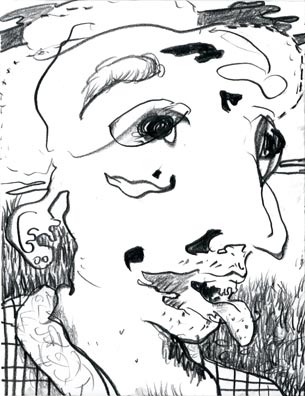
In today's New York Times, theater critic, Margo Jefferson, asks:
Who knew that the Internet would turn out to be a new frontier for theater; a stage that lets us choose our exits and entrances while playing any part we please?
Consider my hand raised.
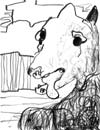 |
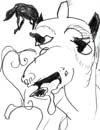 |
 |
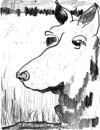 |
 |
 |
 |
 |
 |
 |
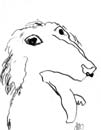 |
 |
 |
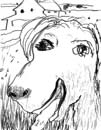 |
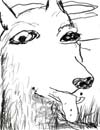 |
For a recent two week stint, I was bestowed the honorific of "Top Dog," leading a pack of three rapturously doggy dogs. The above drawings were created while in the midst of these alternately swirling, dozing and nudging pups.
Speaking of dog days, I ran into a couple from Denver who had escaped the recent mile high heat wave of 105° fahrenheit. They said they found sweltering New York a relief! In the ongoing "debate" as to whether global warming is real, it got me thinking that we've entered a stage where the only remaining operative question is: Are we going to believe our own eyes?
The drawings are arranged in the order of their creation from first to last. Two previous posts are from the same body of work: "pop_galactic_lassie" would be fifth in the series and "pup pant" would be fourth from the last.